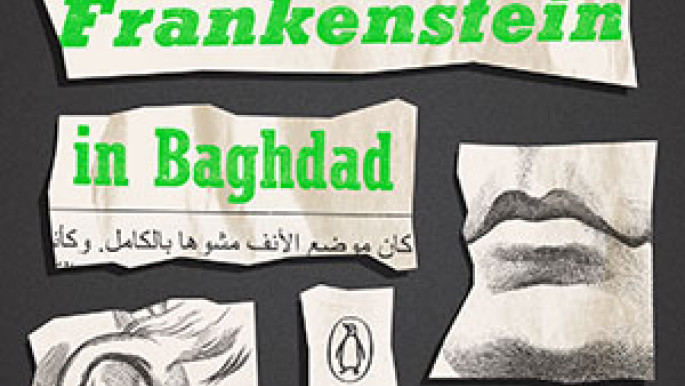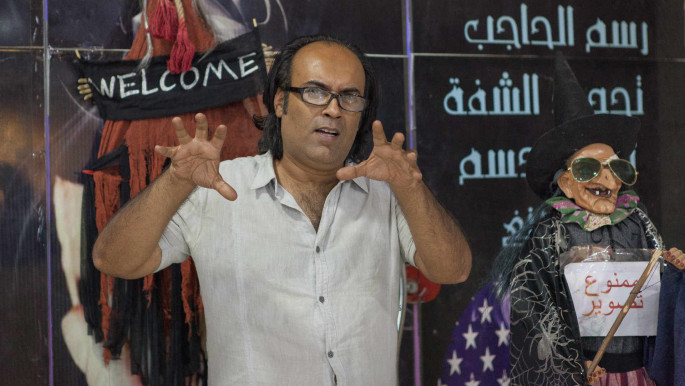Frankenstein in Baghdad: Capturing the dark reality of war with black humour
Amid the mayhem of the post-war period in Baghdad, following the demise of Saddam Hussein, Hadi roams the streets. He is a scavenger, hunting for body parts of the dead, which he then takes home and stitches together.
When we first meet Hadi at the beginning of the novel, Frankenstein in Baghdad, by Iraqi novelist Ahmed Saadawi – the first Iraqi to win the International Prize for Arabic Fiction – he has found a nose which is the final touch to his "corpse."
Hadi is over the age of 50, dishevelled, "with an untrimmed beard, a body that was wiry but hard and energetic, and a bony face with sunken cheeks."
He rarely washes his clothes and alcohol can be smelt on his breath. He recognises that his 'work' is bizarre and grotesque, yet feels it is necessary in his war-time surroundings, for the government to recognise the parts as real people. He feels they require respect and should have a decent burial.
One night, there is an unusually fierce storm in Baghdad and Hadi finds himself caught up in a suicide bombing outside a hotel. He is not fatally injured. However, the guard on shift that night, Hasib, is and subsequently dies on the spot. As a result of the storm, Hadi's corpse disappears and somehow it meets Hasib's soul.
The pair are then intertwined as one and the corpse becomes alive. While Hadi is recovering from his injuries, the corpse, who he calls "Whatsitsname" gets up and disappears.
All this happens within the first 40 pages or so making for a gripping read. A string of horrific and strange murders occur around the city. Soon reports emerge of a horrendous looking criminal who is responsible for these murders yet cannot be killed despite the authorities several failed attempts.
 |
One of the lines our creature says is 'there are no innocents who are completely innocent or criminals who are completely criminal.' This is repeated many times and its powerful stance is not lost on the reader |  |
 |
|
Frankenstein in Baghdad can be enjoyed on many levels. It is a modern take on the classic gothic tale of Frankenstein by Mary Shelley.
The creature Hadi creates has a 'big mouth like gash right across the jaw, a horrible face, stitches across the forehead and down the cheeks, a big nose. So yes, not a pretty picture.
He also finds himself having a purpose: to avenge all the criminals who had committed crimes against them.
He kills an officer in a brothel because he was responsible for the death of someone whose fingers Hadi had taken for his body. Once he is successful, a part of his body decomposes. He discovers that each piece of dead flesh on his body falls off if he doesn't avenge the person it came from within a certain amount of time.
We have a brilliant chapter written from his perspective where he talks about his father, Hadi, and records his story for a magazine. This really gives the reader an insight into his character, his personality, his thoughts and feelings. He describes how Baghdad has become a battleground for the Iraqi National Army and America on one side, versus the Sunni and Shia militias respectively.
The Whatsitsname lives with assistants in an unfinished building who he converses with and who help him stitch "new" body parts once the old ones have fallen off. He realises that he will face an open-ended list of targets if he continues in this manner and is careful in the sense that the flesh he is bought is not that of criminals.
Very cleverly, he questions what makes someone a criminal and the notion of everyone having "a measure of criminality" is discussed.
The language is simple and there is no fluff. Towards the middle of the novel the plot becomes loose and it took a while to pick up.
Included in the plot is Elishva, an elderly Christian woman who convinces herself that the creature is her son Daniel returned from war. We meet Mahmoud, a reporter whose relationship with his editor, Saidi, has a devastating effect on him. Alongside these, we learn about the effects of war on people's lives and property through a hotel owner, Abu Anmar, and a property tycoon, Faraj.
 |
|
| Read an interview with author Ahmed Saadawi here |
One of the lines our creature says is "there are no innocents who are completely innocent or criminals who are completely criminal." This is repeated many times and its powerful stance is not lost on the reader.
The title of the story comes from an article written by Mahmoud, who meets Hadi and wants to hear more about his story. He gives him a recorder to recount events which is then passed on to Whatsitsname. Mahmoud shows his article to Saidi, who changes the title of it to "Frankenstein in Baghdad."
There is a cruel twist at the end of the novel which is very smart. I do question though, whether it is worth the hype. I'm not sure if this was due to the fact it is a translated read so were the missing elements down to the author's work or was something lost along the way. I wanted to feel more of the presence of our creature, hear more from his side. This disconnect is felt in the novel too, where the media portrays the creature as someone who should be feared, thus creating an atmosphere of distrust and unease.
The creature is both victim and villain, and the book itself is very relevant for today. Overall, I felt it was an imaginative book and can see why it was nominated for the Man Booker International Prize 2018, so definitely worth a read.
Amena Ravat is a qualified social worker, a mother and a wife. Reading is her form of escape and something she is very passionate about.
Follow her on Instagram: @theclubofbooks






 Follow the Middle East's top stories in English at The New Arab on Google News
Follow the Middle East's top stories in English at The New Arab on Google News


